Are black holes cool or hot? Black holes are cooler when they are more big. The temperature of stellar black holes is extremely low, almost equal to zero Kelvin, or −273.15 degrees Celsius. It is even cooler for supermassive black holes. However, the event horizon of a black hole is extremely hot.
Black holes have long been objects of fascination and mystery in the universe. From their formation to their effects on surrounding space, they challenge our understanding of physics in profound ways. But one question that often arises is: are black holes cool or hot? Let’s dive into the details and uncover the truth.
Understanding Black Holes

What is a Black Hole?
A black hole is a region in space where gravity is so intense that nothing, not even light, can escape its pull. They form from the remnants of massive stars that collapse under their own gravity after a supernova. Black holes can vary in size, from stellar black holes formed from single stars to supermassive black holes located at the centers of galaxies.
The Event Horizon
The event horizon is the boundary around a black hole beyond which nothing can return. It’s a point of no return where the gravitational pull is so strong that escape is impossible. The event horizon doesn’t have a temperature in the conventional sense, but its effects on nearby matter can provide clues about the black hole’s temperature.
Are black holes cool or hot? Black Hole Temperature Basics
Concept of Temperature in Space
In space, temperature is not just about heat but also about the energy of particles. Temperature in the context of black holes refers to the energy of the particles that could theoretically be emitted or absorbed.
Hawking Radiation
The concept of Hawking radiation was proposed by physicist Stephen Hawking in 1974. According to this theory, black holes can emit radiation due to quantum effects near the event horizon. This radiation leads to the gradual loss of mass and energy from the black hole, causing it to cool down over time. This means that, contrary to common belief, black holes are not entirely “black” but can emit radiation that makes them appear warm.
Black Hole Interior Temperature
Near the Event Horizon
Near the event horizon, the temperature of a black hole can be influenced by various factors, including its mass. Smaller black holes are predicted to be much hotter than larger ones because Hawking radiation increases with smaller mass. For stellar black holes, which are significantly more massive, the temperature is relatively low compared to smaller primordial black holes.
Singularity Temperature

Inside a black hole, at the singularity, the temperature is not well understood due to the extreme conditions where general relativity and quantum mechanics intersect. The singularity is a point where our current theories break down, so predicting its temperature is speculative.
Observational Evidence
Indirect Observations
Indirect observations provide clues about black hole temperatures. By studying the effects of black holes on surrounding matter and radiation, scientists can infer their temperatures. For example, the presence of X-ray emissions from material falling into a black hole can offer indirect evidence of its properties.
Recent Discoveries
Recent studies and discoveries have expanded our understanding of black hole temperatures. Instruments like the Event Horizon Telescope have provided detailed images of black holes, and future missions will likely shed more light on their thermal characteristics.
Comparing Black Hole Temperature
Stellar Black Holes

Stellar black holes typically have temperatures that are much lower than those predicted for smaller black holes. Their immense mass means that the Hawking radiation they emit is negligible in terms of observable temperature.
Supermassive Black Holes
Supermassive black holes, found at the centers of galaxies, have even lower temperatures compared to smaller black holes. Their massive size means they emit very little Hawking radiation, so they are effectively “cool” in terms of temperature.

The Impact of Size and Mass
Smaller Black Holes
Smaller black holes are hotter and emit more radiation compared to their larger counterparts. Primordial black holes, if they exist, would be extremely hot due to their smaller size and could potentially be detected through their radiation.
Larger Black Holes
Larger black holes, such as those found in galactic centers, have much lower temperatures. Their size means that the Hawking radiation they emit is minimal, and their overall thermal emission is relatively cold.
Theoretical Models and Predictions
Current Theories
Current theories about black hole temperatures involve complex calculations of Hawking radiation and gravitational effects. These theories help scientists understand how different types of black holes emit radiation and how their temperatures might vary.
Future Research
Future research aims to refine these theories and improve our understanding of black hole temperatures. Advances in observational technology and theoretical models will continue to reveal new insights into these enigmatic objects.
Black Holes and Cosmic Temperature
Role in the Universe
Black holes play a unique role in the cosmic temperature puzzle. They influence the temperature of their surroundings through their gravitational effects and radiation. Understanding their temperatures helps scientists grasp their impact on the universe.
Influence on Surrounding Matter
Black holes affect nearby matter by pulling it into their gravitational well. This interaction can lead to the emission of high-energy radiation, further influencing the local temperature and dynamics.
Conclusion
So, are black holes cool or hot? The answer depends on the type and size of the black hole in question. Smaller black holes are hotter due to higher levels of Hawking radiation, while larger black holes are cooler. Understanding black hole temperatures provides valuable insights into these mysterious cosmic giants and helps us better understand the universe.
FAQs
- Why are black holes considered hot?
- Black holes can emit Hawking radiation, which makes them appear hot, especially if they are smaller.
- How does Hawking radiation affect black holes?
- Hawking radiation causes black holes to lose mass and energy, leading to a gradual cooling over time.
- Are supermassive black holes hot or cold?
- Supermassive black holes are relatively cold due to their large size, resulting in minimal Hawking radiation.
- What is the temperature of a black hole at the singularity?
- The temperature at the singularity is unknown and not well understood due to the extreme conditions.
- How do scientists measure the temperature of black holes?
- Scientists infer black hole temperatures through indirect methods, such as observing the effects of black holes on surrounding matter and radiation.

